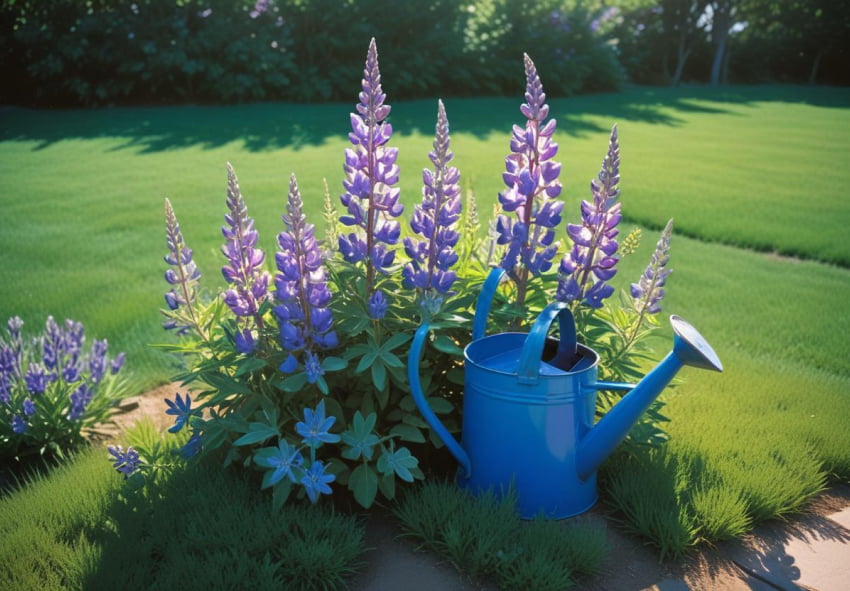Post-planting care is essential for Lupinus, commonly known as lupines, to ensure healthy growth and abundant blooms. This article explores the different aspects of caring for lupines after planting, from watering and fertilizing to pruning and preparing them for winter. Understanding the growth stages and ongoing maintenance requirements of lupines will help you provide the best care for these vibrant and attractive plants. Our gardening blog is a perfect place to find all the information you need!
Watering Lupinus

Watering is a critical aspect of lupine care that influences their growth and flowering potential. Proper watering techniques help ensure that lupines have the necessary moisture without being susceptible to root rot or drought stress. By understanding how much and how often to water, you can provide the ideal conditions for your lupines to thrive.
Initial Watering After Planting
When you first plant lupines, it’s important to give them a thorough watering. This helps settle the soil around the roots and removes any air pockets. Be careful not to overwater, as lupines are sensitive to overly wet conditions. Signs of overwatering include yellowing leaves and a soggy soil surface, while underwatered lupines will have dry, wilted leaves.
Ongoing Watering Requirements
Watering lupinus is important not only after planting your bulbs, but also during the growing process. Main ongoing watering requirements include:
Watering Frequency
- Spring and Summer: Water lupines deeply once a week, allowing the soil to dry slightly between waterings.
- Fall and Winter: Reduce watering frequency to once every two weeks or less, depending on rainfall and soil moisture levels.
Soil Moisture Monitoring
- Check the top inch of soil before watering; if it’s dry to the touch, it’s time to water.
- Use a moisture meter to assess soil conditions more accurately, especially in different soil types.
Adjustments for Soil Type
- Sandy Soils: Require more frequent watering as they drain quickly and don’t retain moisture well.
- Clay Soils: Need less frequent watering because they hold moisture longer and can easily become waterlogged.
Climate Considerations
- In hot, dry climates, increase watering frequency and consider using a drip irrigation system to provide consistent moisture.
- In cooler or wetter climates, reduce watering to prevent over-saturation and potential root rot.
Avoiding Water Stress
- Ensure lupines receive consistent moisture during critical growth phases, such as flowering and seed development, to prevent wilting and promote healthy blooms.
Fertilizing Lupinus
Fertilizing lupines supports robust growth and vibrant blooms. Different types of fertilizers, whether organic or synthetic, have unique advantages and impacts on soil health. Knowing which fertilizers to use and when to apply them is key to ensuring your lupines receive the nutrients they need throughout their growth stages.
Choosing the Right Fertilizer
When selecting a fertilizer for lupines, opt for a balanced or low-nitrogen fertilizer. High nitrogen levels can result in excessive foliage growth at the expense of flowers. Organic fertilizers such as compost, bone meal, or fish emulsion provide a slow release of nutrients and improve soil structure over time. In contrast, synthetic fertilizers offer immediate nutrient availability but can lead to soil acidification and potential nutrient run-off. Consider the pros and cons of both types to determine which aligns with your gardening practices.
Fertilizing Schedule

Here are some tips for your fertilizing schedule for lupinus:
- Early Spring Application: Apply a balanced, slow-release fertilizer or compost in early spring as new growth emerges to support vigorous growth.
- Pre-Bloom Boost: Before the flowering period, use a fertilizer high in phosphorus to promote abundant and vibrant blooms.
- Post-Bloom Feeding: After the blooming phase, apply a nitrogen-rich fertilizer to encourage foliage growth and plant health.
- Mid-Summer Maintenance: If needed, supplement with a light application of balanced fertilizer during mid-summer to support ongoing growth, especially in nutrient-poor soils.
- Late Fall Feeding: Apply compost or an organic fertilizer in late fall to enrich the soil and prepare the plants for winter dormancy and early spring growth.
Mulching and Soil Care
Mulching and maintaining healthy soil are foundational practices in lupine care. Understanding the benefits of mulching and how to maintain the right soil pH and nutrient balance can greatly enhance the growth and vitality of your lupines.
Benefits of Mulching
Mulching helps retain soil moisture, suppresses weed growth, and moderates soil temperature. Organic mulches like wood chips, straw, or leaf mold are ideal for lupines as they slowly break down, adding nutrients to the soil. Apply a 2-3 inch layer of mulch around the base of the plants, keeping it a few inches away from the stems to prevent rot.
Maintaining Healthy Soil
Lupines prefer slightly acidic to neutral soil with a pH of 6.0 to 7.5. Regular soil testing can help you monitor and adjust the pH and nutrient levels. To improve soil quality, incorporate organic matter such as compost or well-rotted manure into the soil. This enhances drainage, aeration, and nutrient availability, creating an ideal environment for lupines to thrive.
Pruning and Deadheading Lupinus
Pruning and deadheading are important techniques for promoting continuous flowering and maintaining the overall shape and health of your lupines. Learning the best practices for pruning and deadheading can help you enjoy a longer and more vibrant display of flowers.
When and How to Prune
Regular pruning helps maintain the plant’s shape and encourages a bushier habit. Here are some tips for you:
- Early Spring Pruning: Remove any damaged or dead stems as new growth begins to encourage healthy development.
- Post-Bloom Pruning: After the first flowering, cut back spent flower spikes to encourage a second round of blooms and prevent self-seeding.
- Late Summer Maintenance: Conduct a light pruning to remove faded blooms and any unhealthy foliage, promoting a tidy appearance.
- Fall Cleanup: In late fall, cut the plant down to a few inches above the ground to prepare it for winter dormancy and reduce disease risks.
Deadheading Spent Blooms
Removing spent flowers, or deadheading, prevents lupines from setting seed and encourages the plant to produce more blooms. To deadhead lupines, simply snip off the flower spike once the blooms have faded, cutting just above the next leaf set. This simple practice can extend the flowering season and keep your lupines looking their best.
Supporting Lupinus Growth

Providing adequate support and using companion planting strategies can enhance the health and aesthetics of your lupines.
Staking and Support Techniques
Tall lupine varieties may require staking to prevent them from flopping over. Insert stakes or plant supports early in the season to avoid damaging the roots. Use soft ties to secure the stems to the stakes, allowing room for natural movement.
Companion Planting
Companion planting with lupines can provide mutual benefits. For example, planting lupines with marigolds, nasturtiums, or calendula can help deter pests. Additionally, lupines fix nitrogen in the soil, benefiting neighboring plants. Consider pairing lupines with other perennials like delphiniums, echinacea, or irises for a visually stunning and ecologically balanced garden.
Preparing Lupinus for Winter
Winter preparation is crucial to protect lupines from cold damage and ensure their survival through the dormant season.
Winterizing Lupinus Plants
Before the first frost, apply a thick layer of mulch around the base of the lupines to insulate the roots and regulate soil temperature. In regions with harsh winters, cover the plants with burlap or frost cloth to protect them from freezing temperatures and harsh winds.
Lupinus Care in Different Climates
Adapting care practices to your specific USDA zone and local climate conditions is essential for successful lupine growth:
- Cold Climates (USDA Zones 3-5): Mulch heavily around the base of the plants to protect roots from freezing temperatures. Choose cold-hardy Lupinus varieties, and cover plants with burlap or frost cloth during severe cold spells.
- Moderate Climates (USDA Zones 6-8): Regularly water Lupinus, especially during dry spells, to keep the soil moist but not waterlogged. Provide afternoon shade in areas with hot summers to prevent heat stress.
- Warm Climates (USDA Zones 9-10): Plant Lupinus in locations with partial shade to protect them from intense sunlight. Use drought-tolerant varieties and increase the frequency of watering during the hottest months.
- Coastal Climates: Select salt-tolerant Lupinus varieties that can withstand salty air and soil conditions. Ensure good drainage to prevent root rot from excessive moisture.
- Mountainous Regions: Opt for high-altitude varieties that are adapted to cooler temperatures and shorter growing seasons. Protect plants from harsh winds with windbreaks or by planting in sheltered locations.
Conclusion
Caring for lupines after planting involves a combination of proper watering, fertilizing, pruning, and winter preparation. By monitoring and adjusting your care routines, you can ensure the long-lasting beauty and health of your lupines, providing vibrant color and texture to your garden throughout the growing season.
Frequently Asked Questions (FAQs) about Lupinus After Planting
1. How often should I water my Lupinus plants?
Lupinus plants prefer consistently moist soil. Water them deeply once a week, increasing the frequency during hot and dry weather. Be sure not to let the soil dry out completely between waterings, as this can stress the plants and reduce their flowering potential.
2. What type of fertilizer should I use for Lupinus?
Use a balanced, slow-release fertilizer with a higher phosphorus content to encourage healthy root and flower development. Organic options like compost or well-rotted manure are also beneficial. Apply fertilizer in the spring when new growth begins, and reapply every 4-6 weeks during the growing season.
3. When is the best time to prune Lupinus plants?
Prune Lupinus in early spring to remove any dead or damaged stems and in late summer after the flowering period to promote bushier growth and more blooms the following year. Regular pruning also helps maintain the plant’s shape and prevents it from becoming leggy.
4. Can I order lupinus plants from your online store?
We are pleased to offer a variety of lupinus for sale. Our selection includes different lupinus cultivars, each with its unique foliage and characteristics. You can browse our online store Dutch-bulbs.com to explore the options, and with a few clicks, you can have lupinus plants delivered to your doorstep.
5. How can I protect my Lupinus plants during winter?
In colder climates, mulch heavily around the base of the plants and consider covering them with a frost cloth or burlap to protect against freezing temperatures. This will help insulate the roots and keep them from being damaged by frost heave.
Published: 15.08.2024
